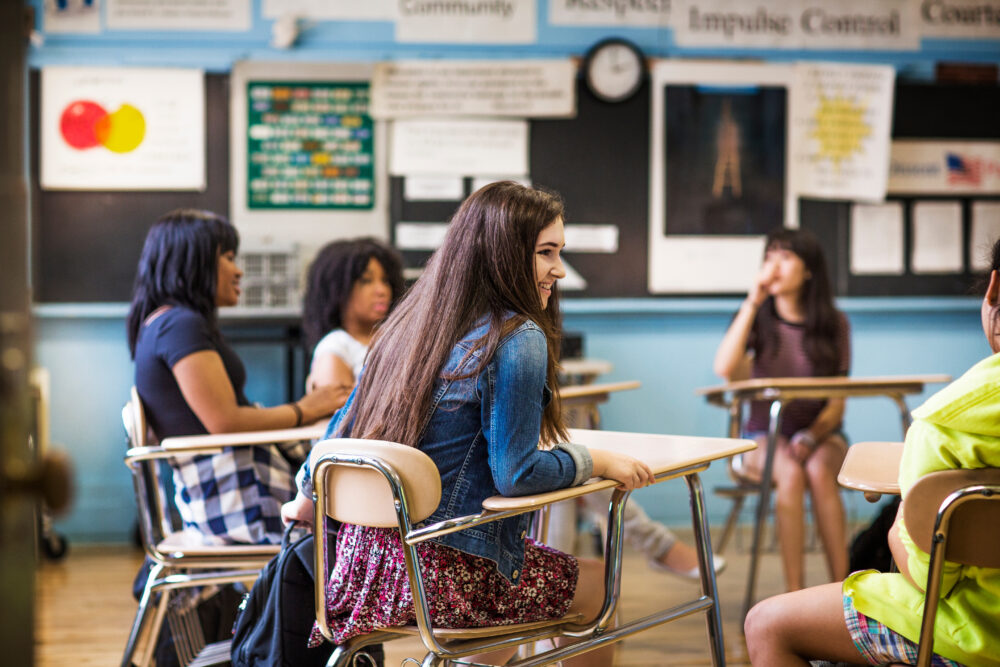City Budget Priorities for Fiscal Year 2025
The Fiscal Year 2025 budget must save education programs that are providing critical support to some of New York City’s most marginalized students and families.

We are pleased that the Mayor’s Executive Budget includes around $600 million for critical education programs, services, and staff positions that were at risk of drastic cuts or elimination due to the expiration of federal COVID-19 stimulus funds, including 3-K and preschool special education, 100 shelter-based community coordinators, 500 school social workers and psychologists, more than 100 community schools, Learning to Work programs, bilingual supports, translation and interpretation services, and programs to support students with dyslexia. These initiatives benefit hundreds of thousands of New York City students every year, and their loss would have been devastating for both individual young people and school communities.
While we acknowledge and appreciate the funding committed in the Executive Budget, there is more work to do: several vital programs—the Mental Health Continuum, Promise NYC, immigrant family communications, and Student Success Centers—were left out of the Mayor’s budget and remain on the chopping block due to expiring funds; the investments in 3-K, restorative justice, and community schools do not represent a full restoration of current funding levels; and the investments in preschool special education are not sufficient to meet the need. We are glad that the City Council response to the preliminary budget included the need to restore funding for each of these programs. Elected leaders must protect funding for public education and ensure the City does not take steps that would violate the civil rights of students with disabilities and other high-needs populations. While funding is on the chopping block, the needs are not going away.
At the same time, the City must also address the longstanding inaccessibility of school buildings by allocating an additional $450 million—for a total investment of $1.25 billion—for school accessibility projects in the 2025–2029 Capital Plan. As of the start of the 2023–24 school year, only 31% of schools are fully accessible to students, teachers, parents, and community members with disabilities.
FY 2025 Expense Budget Priorities
-
3-K and Pre-K
3-K and Pre-K attract families into the public system at the very start of their children’s education and provide high-quality early learning opportunities to children who otherwise would not have access—helping prepare them for success in kindergarten and beyond. The number of children participating in 3-K doubled from 17,500 in 2019–20 to 35,700 in 2022–23 thanks to the investment of federal funds. While the Executive Budget includes $92M in one-year funding to make up for the loss of federal dollars, as well as an additional $3.5M for outreach, a funding gap of $170M remains due to proposed city budget cuts to 3-K and Pre-K.
-
Preschool Special Education
Even as NYC has expanded 3-K and Pre-K, thousands of 3- and 4-year-olds with disabilities are still denied their rights to preschool special education programs and services. The City used $96M in soon-to-expire federal stimulus funds to support preschoolers with disabilities including by offering a “contract enhancement” to preschool special education programs run by community-based organizations, many of which had been closing classes due to financial challenges; hiring preschool related service providers; and adding Committee on Preschool Special Education staff to help address delays in evaluating and serving children. The FY 2025 Executive Budget includes $83M toward continuing these efforts going forward. However, even with this year’s $96M federal investment, thousands of preschoolers with disabilities are currently waiting for their legally mandated services and more than 700 children are waiting for a seat in a preschool special education class—in violation of both their legal rights and the Mayor’s December 2022 promise to address the longstanding shortage of seats. While the Executive Budget adds $25M in one-year funding for preschool special education classes in district schools, NYCPS itself has acknowledged that this allocation is not sufficient to meet the need; the request it submitted to the Office of Management and Budget (OMB) for preschool special education classes and services was for five times as much ($125M). The $25M investment would leave hundreds of preschoolers waiting for their legally mandated special education classes and thousands waiting for their legally mandated services in the coming year. Whether the City will uphold the civil rights of young children with disabilities—or leave thousands waiting for support at a critical stage in their development—should not be a question left to OMB’s discretion. The City should invest an additional $100M, as requested by NYCPS, to help ensure all preschoolers with disabilities receive their legally mandated special education classes and services in a timely manner.
-
Promise NYC
No child should be turned away from an early learning program because of their immigration status, and in January 2023, the City launched Promise NYC to increase access to subsidized childcare for children who would otherwise be ineligible for existing programs due to federal restrictions. More than 600 children are now enrolled in childcare programs thanks to Promise NYC, which is supported by $16M in expiring one-year Administration for Children’s Services (ACS) funding. The number of children who stand to benefit from Promise NYC has only grown larger since the program was first announced; access to early care and education will help prepare immigrant children for success in elementary school and beyond, while also enabling their parents to work and connect with resources. The Executive Budget does not include funding to continue this program beyond June. We support the recommendation made by the City Council in its response to the preliminary budget to sustain this program and increase funding from $16M to $25M.
-
Immigrant Family Communication & Outreach
This initiative strengthens New York City Public Schools (NYCPS)’s communication with immigrant families—many of whom would otherwise be left without important information—by using local ethnic media to share school-related updates, sending paper notices to families’ homes, reaching families via phone calls and text messages, and collaborating with immigrant-facing community-based organizations to create and launch information campaigns. It is critical for this initiative to continue, especially given the recent increase in the number of newly arrived immigrant families in New York City, but it is supported by $4M in one-year city funding that was left out of the Executive Budget.
-
The Mental Health Continuum
The Mental Health Continuum is a cross-agency partnership (NYCPS, Health + Hospitals, Department of Health & Mental Hygiene) to help students with significant mental health needs access expedited mental healthcare. This innovative model, which was highlighted in the Mayor’s Mental Health Plan and the City Council’s Mental Health Roadmap, supports students at more than 50 high-needs schools through school partnerships with H+H mental health clinics, dedicated staff to provide students with timely access to mental health services, a NYC Well hotline to advise school staff, mobile response teams to respond to students in crisis, and training for school staff in Collaborative Problem Solving to build their capacity to address student behavior. Recognizing the youth mental health crisis, the Mayor announced in April that the City would open 16 mental health clinics as part of the Mental Health Continuum. Yet, the $5M in one-year city funding for this initiative (NYCPS: $787K, H+H: $3.74M, DOHMH: $472K) is expiring in June and was left out of the Executive Budget.
-
Restorative Justice Practices
One-time federal funding represents the bulk of the City’s investment in restorative justice practices, which enable schools to use alternatives to exclusionary discipline that keep students in the classroom while helping them build and repair relationships. NYCPS allocated $12M in expiring federal dollars for restorative practices. All students deserve schools where they feel safe and supported, but without sufficient resources and appropriate alternatives for addressing behavior and helping students navigate conflict, schools will continue to resort to suspensions—which do not make schools safer; disproportionately impact students of color, students with disabilities, and youth who are homeless or in the foster system; and have been linked with lower educational attainment and higher odds of future contact with the juvenile or criminal legal system. While the Mayor has committed to investing $6M in restorative practices to help offset the loss of federal dollars, a $6M gap remains.
-
Community Schools
Community schools provide students and their families with wrap-around supports and services, such as after-school programming, adult education classes, and medical, dental, and mental healthcare. This initiative, which expanded from 266 to more than 400 schools thanks to expiring federal and city funds, has proven effective at lowering chronic absenteeism and increasing on-time high school graduation rates. While the Executive Budget includes a $56M restoration for community schools, there is still a $14M gap due to one-year city funding that expires in June.
-
Student Success Centers
NYCPS used $3.3M in expiring federal stimulus funding to support Student Success Centers in 34 high schools, where trained youth leaders build a culture of college-going in their schools and help their peers with the college admissions process. Continued funding for this initiative ($3.3M) was left out of the Mayor’s budget.
2025–2029 Capital Budget Priority: Improve School Accessibility
More than 30 years after the Americans with Disabilities Act (ADA) prohibited discrimination on the basis of disability, physical barriers to full inclusion remain widespread in New York City’s schools—and as a result, New Yorkers with disabilities continue to be excluded from buildings that are central to public life. In fact, as of the start of the 2023–24 school year, only 31% of schools are fully accessible to students, teachers, parents, and community members with disabilities.
Five years ago, the situation was much worse—fewer than one in five schools was fully accessible as of the start of the 2018–19 school year—and New York City invested a historic $750 million in the 2020–2024 Capital Plan to improve school accessibility. While this funding has enabled significant progress, there is much work left to do: NYC Public Schools itself estimated that it would take $1 billion in each of the next four five-year plans to reach “maximum practical accessibility” by 2045.
At a minimum, the City must make the investments necessary to keep pace with the work done over the past five years. The proposed 2025–2029 Capital Plan includes $800 million for school accessibility projects, an amount that would represent a decreased commitment to improving school accessibility once inflation is taken into account. This sum represents less than 5% of all proposed capital spending for NYC Public Schools for the next five years.
The City should allocate an additional $450 million—for a total investment of $1.25 billion—for school accessibility projects in the 2025–2029 Capital Plan, with the goal of making at least 50% of buildings that serve as the primary location for a school fully accessible by 2030.
-
Download our full budget agenda
Updated June 7, 2024


